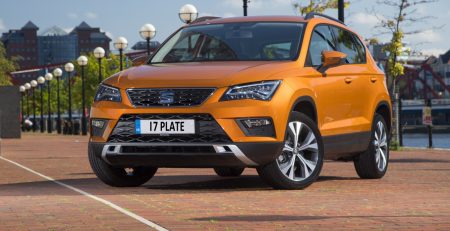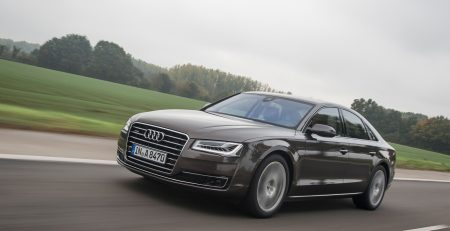London announced a T-charge from late 2017 for Euro 4 (EU4) vehicles, while Stuttgart banned Euro 5 too. Will London step u read more
Range Rover Sport First Drive Review
Advantages
Better than the old car in every way possible. The sheer versatility of the new Range Rover Sport puts it on a pedestal above rivals, although the Porsche Cayenne runs it close. Fuel economy for the SDV6 engine is excellent for such a capable and luxurious vehicle.
Disadvantages
Land Rover has understandably increased the base price of the Range Rover Sport and the entry-level TDV6 SE model starts at £51,550, for which options such as the panoramic roof cost £1,500. Fuel economy in the 5.0 V8 Supercharged petrol model is laughable, and hovers around 18mpg in normal driving conditions.
Summary
Land Rover sold over 415,000 examples of the original Range Rover Sport, with peak sales quite incredibly coming in 2012. Now the new car has a heavily revised design, a comprehensively reworked chassis and suspension setup as well as more efficient engines. Land Rover bills it as the most versatile car in the world, so is it?
To cut to the chase, yes. Or, at least, it’s very, very close. The old car’s principal bugbear, apart from some unnecessarily brutal styling, was that the chassis undermined the Sport’s athletic credentials. It liked to rest on hedges and dry stone walls during cornering.
The new car is a different proposition. An aluminium monocoque and bodywork saves several hundred kilograms in weight, something on which a chassis that is 25% stiffer with continuously variable dampers capitalizes. Put simply, the car corners like a hot-hatch. In Dynamic mode, torque vectoring even brakes the inside wheels to drag the car around corners with extra agility and fire it out the other side. Few cars can cover ground with such ease.
Two engines are available this summer – a 288bhp 3.0-litre SDV6 diesel and the ludicrous 5.0 Supercharged V8 – with an entry level TDV6 arriving in January. The likely best seller, and in AutoeBid’s opinion the one to have, is the SDV6. It blends smooth and refined power delivery with outstanding fuel economy for a car of this size and luxurious nature.
Land Rover claims a combined 37.7mpg for the SDV6 and we’re inclined to believe it. After guiding the Sport 250 miles through the Brecon Beacons, Land Rover’s demanding off-road course at Eastnor Castle and along fast dual carriageways it returned 27.7mpg. That’s remarkable, given that our itinerary in no way resembled normal driving conditions.
Land Rover expects most 5.0 V8 Sport’s to go to US and Middle and Far Eastern markets. That’s hardly surprising, given that, for all the warm resonance of its tuned exhaust and frightening cross-country pace, owners will struggle to surpass 20mpg. The price we paid for exploiting its 503bhp? 11.9mpg.
So the new Sport is fast in a straight line, economical (with the right engine) and corners well, but owners will still expect near Rolls-Royce levels of refinement inside. The simple but beautifully appointed cabin architecture is a real highlight for all Range Rovers, which feature an expansive leather-clad dashboard and natural wood and metal detailing. It’s been executed better than before, too. Buttons and switches fit properly and there are no shakes or rattles.
The Sport also features twin TFT screens that are both smooth and clear. They work well, and the car’s seemingly endless array of software – pertaining to everything from playing DVDs to the car’s impressive 850mm wading depth – runs seamlessly. The Sport is a breath of fresh air in comparison to the dark, button and dial infested interiors of its many German rivals.
Land Rover estimate that less than 10% of Sport models will ever get close to their theoretical limits off-road. Having completed Land Rover’s off-road assault course at Eastnor Castle that’s not hard to imagine. A low-range gearbox makes controlling the 2115kg Sport very easy, and any steep and slippery descents or climbs are casually dispatched by a combination of locking differentials, active traction control systems and colossal all-weather tyres. In auto mode the Sport is perpetually deciding which of its five modes – general, grass/gravel/snow, mud/ruts, sand and crawl – it should be in and sets itself up accordingly. Wheel articulation and wading depth are within touching distance of the flagship Range Rover, too, so there is no doubt the Sport can be a bona fide off-roader when needs be.
It’s this versatility that’s the Range Rover Sport’s strongest asset and its ability to switch between tarmac and less comfortable terrain is nothing short of astonishing. Especially given how easy it all is for the driver. Factor in a more mature design and added opulence inside and it’s clear that the Range Rover Sport fully deserves the success it will undoubtedly achieve. It’s a brilliant car.
AutoeBid Choice: 3.0 SDV6 HSE, from £59,995 OTR.
Comfort 5 stars Style 5 stars Handling 4 stars Depreciation 4 starsEconomy 4 stars




